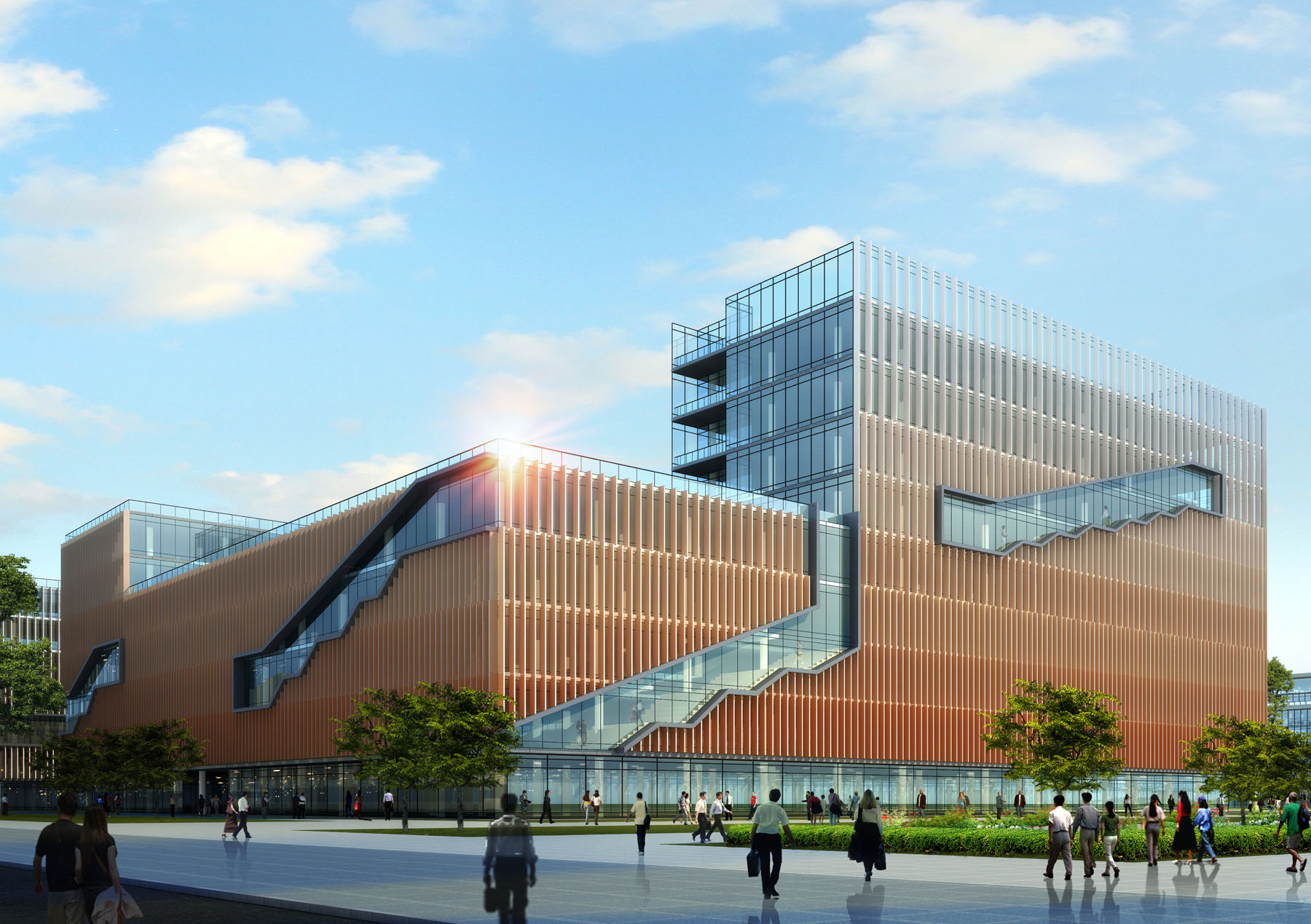China Mobile Ltd. selected international architecture, planning, engineering, interior design and program management firm LEO A DALY to design three buildings at its new international headquarters campus in Beijing.
In partnership with Local Design Institute WDCE, LEO A DALY won a competition to design Phase 2, Plot B, of the campus. The new international headquarters, which will be built in several phases in an area of 1.3 million square meters, consists of a campus of 26 specialized buildings to accommodate a variety of functions, including information collection, research and innovation, information services, international cooperation and exchange and display functions.
Phase 2, Plot B, of the campus, which totals 148,000 square meters near a green park space, consists of two research and development office and laboratory buildings, and a public facility building. As lead designer, LEO A DALY is providing the exterior design for the three buildings, interior design for the buildings’ major public spaces and landscape architecture while WDCE is providing interior design services for the rest of the spaces as well as all engineering work.
LEO A DALY’s design for the research and development office and laboratory buildings, each a five- and nine-story facility, are organized on an east-west pedestrian axis and mirrored in their massing to establish opposite, formal entries linked to internal courtyards at the ground level.
Each sculpted block features facades that convey the dynamic activity within by way of large, diagonal windows. The windows reveal perimeter stairs, which act as impromptu gathering steps with excellent views to the landscape. Central to LEO A DALY’s design concept is taking conventional, internal stairways typically found in research buildings’ central core zones and placing them on the perimeter in which employee brain storming activities may freely flow. This design approach of providing informal interacting zones is currently adopted by leading global research and technology firms whose goal is to support new work lifestyles preferred by younger generations.
The buildings feature fenestration that shades the external glass skin with copper-colored brise-soleil, graduated in color from dark at the bottom to light at the top, to visually ease the building’s mass and suggest an organic quality which links the building to the site. The two buildings are being designed with emphasis on reducing ecological and energy consumption impact. The buildings’ roofs provide sustainable landscape areas and are planted with grasses, annual and perennial materials and include some man-made materials (such as colorful rubber-based walking surfaces). The landscape for both perimeters and courtyards feature sculptural earth forms, fountains, pools, terraces and gardens.
A third, public facilities building is placed adjacent to the research and laboratory buildings in the campus’s central park and signature waterway. Within this building, recreation, food and beverage, light retail and central campus meeting facilities provide a multilevel, public place for both employees and China Mobile visitors. Its architecture is differentiated from the adjacent buildings by the portrayal of careful massing and purposeful sculpting of form, reinforced by diagonal fins which artfully echo the treatment of its neighbors. The cladding, materials and roofing of the facility incorporate a number of sustainable features, and are designed to meet Three Star Green Building standards (equivalent to LEED Platinum criteria), the highest rating for sustainable buildings in China. BD+C
Related Stories
Adaptive Reuse | Mar 21, 2024
Massachusetts launches program to spur office-to-residential conversions statewide
Massachusetts Gov. Maura Healey recently launched a program to help cities across the state identify underused office buildings that are best suited for residential conversions.
Legislation | Mar 21, 2024
Bill would mandate solar panels on public buildings in New York City
A recently introduced bill in the New York City Council would mandate solar panel installations on the roofs of all city-owned buildings. The legislation would require 100 MW of solar photovoltaic systems be installed on public buildings by the end of 2025.
Office Buildings | Mar 21, 2024
BOMA updates floor measurement standard for office buildings
The Building Owners and Managers Association (BOMA) International has released its latest floor measurement standard for office buildings, BOMA 2024 for Office Buildings – ANSI/BOMA Z65.1-2024.
Healthcare Facilities | Mar 18, 2024
A modular construction solution to the mental healthcare crisis
Maria Ionescu, Senior Medical Planner, Stantec, shares a tested solution for the overburdened emergency department: Modular hub-and-spoke design.
Codes and Standards | Mar 18, 2024
New urban stormwater policies treat rainwater as a resource
U.S. cities are revamping how they handle stormwater to reduce flooding and capture rainfall and recharge aquifers. New policies reflect a change in mindset from treating stormwater as a nuisance to be quickly diverted away to capturing it as a resource.
Plumbing | Mar 18, 2024
EPA to revise criteria for WaterSense faucets and faucet accessories
The U.S. Environmental Protection Agency (EPA) plans to revise its criteria for faucets and faucet accessories to earn the WaterSense label. The specification launched in 2007; since then, most faucets now sold in the U.S. meet or exceed the current WaterSense maximum flow rate of 1.5 gallons per minute (gpm).
MFPRO+ New Projects | Mar 18, 2024
Luxury apartments in New York restore and renovate a century-old residential building
COOKFOX Architects has completed a luxury apartment building at 378 West End Avenue in New York City. The project restored and renovated the original residence built in 1915, while extending a new structure east on West 78th Street.
Multifamily Housing | Mar 18, 2024
YWCA building in Boston’s Back Bay converted into 210 affordable rental apartments
Renovation of YWCA at 140 Clarendon Street will serve 111 previously unhoused families and individuals.
Healthcare Facilities | Mar 17, 2024
5 criteria to optimize medical office design
Healthcare designers need to consider privacy, separate areas for practitioners, natural light, outdoor spaces, and thoughtful selection of materials for medical office buildings.
Construction Costs | Mar 15, 2024
Retail center construction costs for 2024
Data from Gordian shows the most recent costs per square foot for restaurants, social clubs, one-story department stores, retail stores and movie theaters in select cities.

















